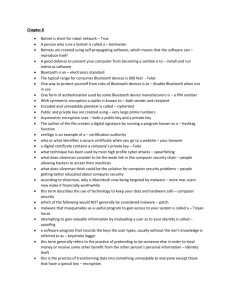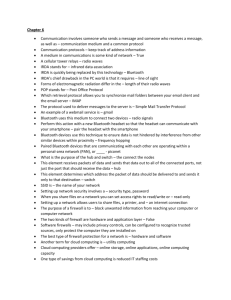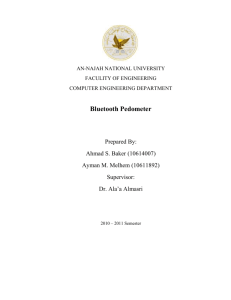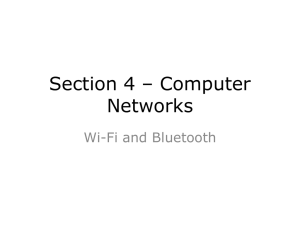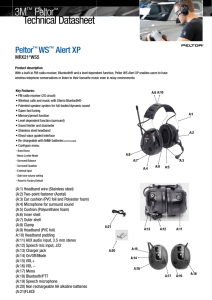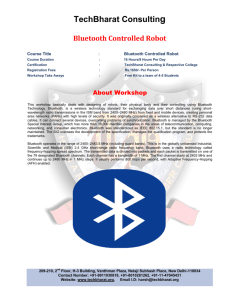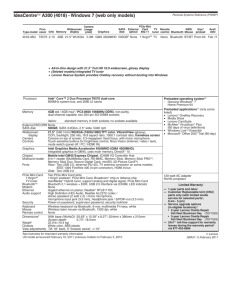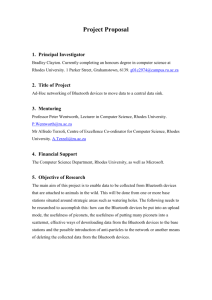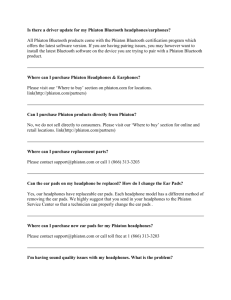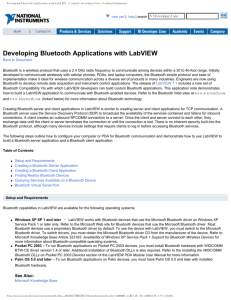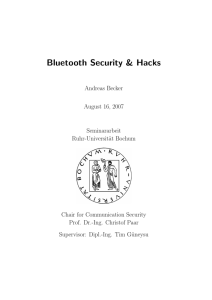Team Tile Item Finder - Georgetown Digital Commons
advertisement
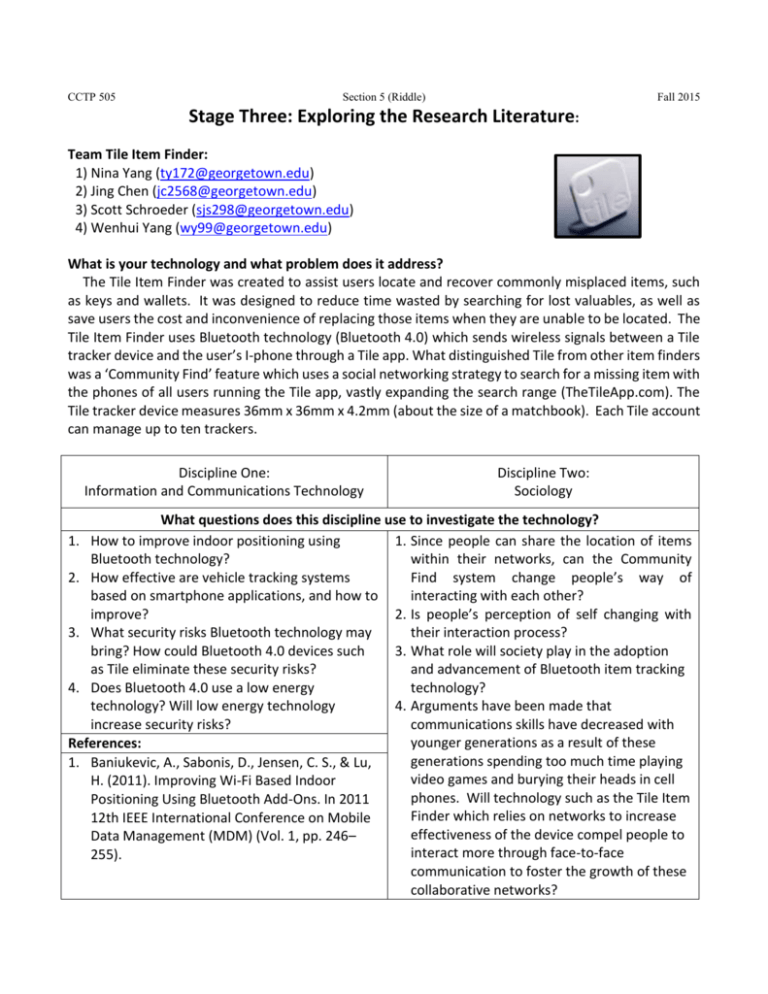
CCTP 505 Section 5 (Riddle) Fall 2015 Stage Three: Exploring the Research Literature: Team Tile Item Finder: 1) Nina Yang (ty172@georgetown.edu) 2) Jing Chen (jc2568@georgetown.edu) 3) Scott Schroeder (sjs298@georgetown.edu) 4) Wenhui Yang (wy99@georgetown.edu) What is your technology and what problem does it address? The Tile Item Finder was created to assist users locate and recover commonly misplaced items, such as keys and wallets. It was designed to reduce time wasted by searching for lost valuables, as well as save users the cost and inconvenience of replacing those items when they are unable to be located. The Tile Item Finder uses Bluetooth technology (Bluetooth 4.0) which sends wireless signals between a Tile tracker device and the user’s I-phone through a Tile app. What distinguished Tile from other item finders was a ‘Community Find’ feature which uses a social networking strategy to search for a missing item with the phones of all users running the Tile app, vastly expanding the search range (TheTileApp.com). The Tile tracker device measures 36mm x 36mm x 4.2mm (about the size of a matchbook). Each Tile account can manage up to ten trackers. Discipline One: Information and Communications Technology Discipline Two: Sociology What questions does this discipline use to investigate the technology? 1. How to improve indoor positioning using 1. Since people can share the location of items Bluetooth technology? within their networks, can the Community 2. How effective are vehicle tracking systems Find system change people’s way of based on smartphone applications, and how to interacting with each other? improve? 2. Is people’s perception of self changing with 3. What security risks Bluetooth technology may their interaction process? bring? How could Bluetooth 4.0 devices such 3. What role will society play in the adoption as Tile eliminate these security risks? and advancement of Bluetooth item tracking 4. Does Bluetooth 4.0 use a low energy technology? technology? Will low energy technology 4. Arguments have been made that increase security risks? communications skills have decreased with younger generations as a result of these References: generations spending too much time playing 1. Baniukevic, A., Sabonis, D., Jensen, C. S., & Lu, video games and burying their heads in cell H. (2011). Improving Wi-Fi Based Indoor phones. Will technology such as the Tile Item Positioning Using Bluetooth Add-Ons. In 2011 Finder which relies on networks to increase 12th IEEE International Conference on Mobile effectiveness of the device compel people to Data Management (MDM) (Vol. 1, pp. 246– interact more through face-to-face 255). communication to foster the growth of these collaborative networks? CCTP 505 Section 5 (Riddle) 2. Muñoz-Organero, M., J. Muñoz-Merino, P., & Delgado Kloos, C. (2012). Using Bluetooth to Implement a Pervasive Indoor Positioning System with Minimal Requirements at the Application Level. Mobile Information Systems, 8(1), 73–82. 3. Baniukevic, A., Jensen, C. S., & Lu, H. (2013). Hybrid Indoor Positioning with Wi-Fi and Bluetooth: 4. Architecture and Performance. In 2013 IEEE 14th International Conference on Mobile Data Management (MDM) (Vol. 1, pp. 207–216). 5. Shrivastava, Manish. “Analysis of Security Risks in Bluetooth.” International Journal of Computing Academic Research ($2305-9184) 1, no. 2 (2012): 88–95. 6. Lu, Ling Xin, Zhang-Qin Huang, Yi-Bin Hou, Jing Li, and Shu-feng Wang. “A Safe and Fast Connecting Strategy of the Bluetooth Identification Sensors in Ambient Intelligence Environment.” In 2008 International Symposiums on Information Processing (ISIP), 538–42, 2008. doi:10.1109/ISIP.2008.91. 7. Jakobsson, Markus, and Susanne Wetzel. “Security Weaknesses in Bluetooth.” In Topics in Cryptology — CT-RSA 2001, edited by David Naccache, 176–91. Lecture Notes in Computer Science 2020. Springer Berlin Heidelberg, 2001. 8. “Beken License CEVA Bluetooth 2.1+EDR and 4.0 IP for Low Power Bluetooth Product Families: CEVA-Bluetooth Platforms Provide Beken with Cost-Efficient, Highly-Integrated Solutions for Bluetooth-Enabled ICs.” PR Newswire. March 19, 2013. 9. Siekkinen, M., M. Hiienkari, J.K. Nurminen, and J. Nieminen. “How Low Energy Is Bluetooth Low Energy? Comparative Measurements with ZigBee/802.15.4.” In 2012 IEEE Wireless Communications and Networking Conference Workshops (WCNCW), 10. Jara, A.J., D. Fern’ndez, P. Lopez, M.A. Zamora, B. Ubeda, and A.G. Skarmeta. “Evaluation of Bluetooth Low Energy Capabilities for Fall 2015 References: 1. McLuhan, M. (1994). Understanding media: The extensions of man. MIT press. 2. Burke, Peter J., and Stets, Jan E(2009) Identity Theory. New York, NY: Oxford University Press. 3. George Herbert Mead, Mind, Self and Society: From the Standpoint of a Social Behavioralist, edited and with an introduction by C. W. Morris, Chicago, IL: University of Chicago Press. 4. Miyazaki, A. (2012). Becoming a functioning member of the collegiate culture: How cellphone communication affects first-year college students’ self and identity in college transition (Ph.D.). Wayne State University, United States -- Michigan. 5. Mohr, A. (2010). On the relationship between mobile technology and quality of life (Order No. 1476447). Available from Dissertations & Theses @ Georgetown University - WRLC; ProQuest Dissertations & Theses Global: Business; ProQuest Dissertations & Theses Global: Science & Technology; ProQuest Dissertations & Theses Global: Social Sciences. 6. Schmidt, T. W.The ritualization of communication developments: Institutions and McDonaldized communication of everyday life (Order No. AAI1506753). 7. Ma, H., & Chen, Y. (2009). A quality-oriented framework with QoS management using bluetooth as a case. Quality and Quantity, 43(4), 645-652. 8. van, d. V. (2015). Leaky apps and data shots: Technologies of leakage and insertion in NSA-surveillance. Surveillance & Society, 13(2), 182-196. CCTP 505 Section 5 (Riddle) Continuous Data Transmission from a Wearable Electrocardiogram.” In 2012 Sixth International Conference on Innovative Mobile and Internet Services in Ubiquitous Computing (IMIS), 912–17, 2012. doi:10.1109/IMIS.2012.201. Fall 2015


